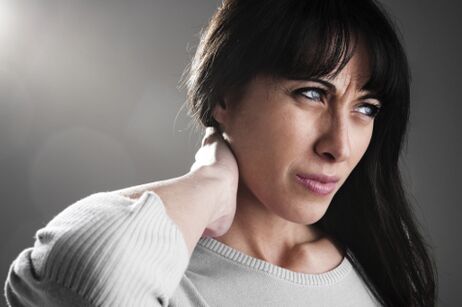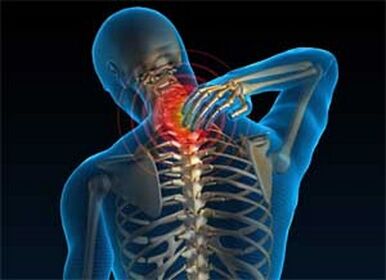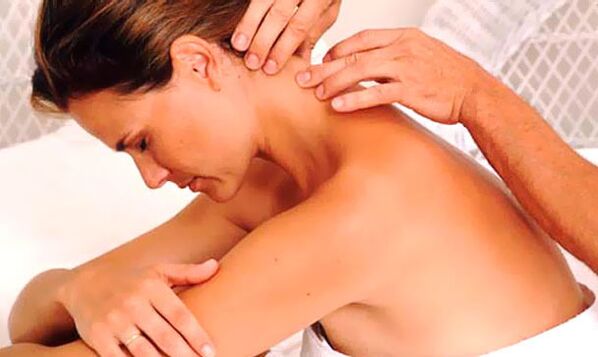
It is very sad to realize, but at this time, almost everyone who has reached the 25th anniversary suffer from cervical vertebral osteochondrosis.In cervical vertebrae, the disease is the most common, compared to other spinal departments.So this topic is very relevant in the modern world.
We will tell you why osteochondrosis occurs, how it shows itself and how to treat it.
Let us also consider medications that work more effectively, and provide examples of exercises needed to treat the disease.
Cervical spinal osteochondrosis is a degenerative process in the intervertebral disc, which significantly reduces their height in the cervical spine.It leads to changes not only in the intervertebral disc, but also in the vertebra and joints of the department.
The cause of the cervical area osteochondrosis
These factors will be listed below, as a result of the action that the pressure on the cervical spine increases.To balance this, the neck muscles try to divert excess load, and as a result there is cramps and blood circulation disorders in this area, which involves degenerative changes.
Causes of cervical osteochondrosis in men and women (factors affecting the development of cervical spinal osteochondrosis):
- violations of posture or spinal curvature;
- Overweight;
- Hypodynamia is an inactive lifestyle (for example, sitting with drivers, office workers);
- trauma or damage to the spine;
- Dot in metabolism:
- frequent physical activity;
- unstable psycho stress or state;
- The physical condition of the muscles is insufficient;
- It is inherited from parents;
- continuously hold the phone with the shoulder;
- The development of anomalies in the cervical spine.

The cause of the cervical spinal osteochondrosis is only aggravated without timely medical intervention.
The development of cervical osteochondrosis
The level of osteochondrosis is not his stage at all.It is determined based on the patient's words and general clinical pictures.We'll get to know the level a little later.
So:
First degree
Minimum manifestations, patients complain of poor pain in the cervical area, which is increasing if you turn your head on.When examined, it can be found that the cervical muscles are slightly tense.
Second
The pain in the cervical spine becomes more intense.It can spread to the shoulders and arms.This is explained by the fact that the height of the intervertebral disc is reduced and the nerve roots are violated.The pain grows when a person leans or turns his head.Patients are worried about headaches, persistent weaknesses and even decreased performance.
Third degree
Explicit symptoms of osteochondrosis show themselves stronger and regularly present.Normal pain in the arm or shoulder can cause the upper limb and muscle weakness as a result of the formation of intervertebral hernia.Persistent weaknesses and dizziness.At the examination, it may reveal that the cervical spine becomes less mobile and pain during the site's feelings.
Fourth degree
The intervertebral disc has been completely destroyed, which is now replacing connective tissue.Dizziness is increasing, sounds occur in the ear, the coordination is interrupted, as the vertebral artery leads to cerebellum and the brain occipital is affected.
The increase in cervical osteochondrosis is very dangerous due to the small size of the department and the huge importance to the entire bone device.Small vertebrate transplantation can cause the most important nerve compression.And educated osteophytes at a later stage will lead to the worst consequences for blood vessels and nerves.Negative results may be hernia or spinal cord, which is why the nerve spine is swollen, and so on inflams.As a complication of cervical osteochondrosis, this is a spinal cord compression.The defeat not only extends to the neck and head, but also to the limbs (initially above).
What are the symptoms of cervical osteochondrosis?
Cervical spinal osteochondrosis is very different in the symptoms of such a disease in other parts of the spine.This can be explained by the fact that in the part of the spinal column, the very small distance between the vertebrae, which means that with the pathology of the nerve and the spinal cord is immediately pinched.

The most common symptoms of osteochondrosis of the cervical spine and thorax:
- Sore.It can be located on the neck and back of the head, on the shoulders or even in the hands.Pain in the occipital part of the head is caused by muscle cramps, which is affixed from the neck to the occipital bone and causes disruption in blood circulation.The sensation of pain in the shoulder or upper limbs is due to the nerve attraction that supplies the muscles -The part of these parts.
- Disadvantages in hand.This is due to damage to the nerves responsible for the movement, the muscles that absorb the hand.
- Reduce hand sensitivity.It seems that during the process of painful nerves, which gives sensitivity to the skin of the upper limbs.
- The movement of the cervical spine in the cervical spine is limited, the crisis when moving the neck.It is explained by the fact that the height of the intervertebral disc is reduced, bone growth appears on the vertebral body and small joints in the affected intervertebral chamber.
Symptoms of cervical osteochondrosis arising in the brain are expressed by weakness, dizziness and adhesion.These symptoms occur when the vertebral artery is involved in the process, which passes through its own channel located in the hole of the cervical vertebral horizontal process.Due to the development of cervical osteochondrosis, fibrous tissue forms, vertebrae are transferred, blood circulation in the artery worsen, which causes deterioration of blood supply to the brain and cerebellum area.
- Language numbness, hearing loss and vision.Symptoms -Symptoms of cervical osteochondrosis, when blood circulation in the brain of the brain, cerebellum and stems worsen.
Lumps in the throat with cervical spinal osteochondrosis are very frequent and not very specific.Many people take it for cold symptoms and fight it with warmth, rinsing and medicine.But this is not a method of struggle, so release does not happen.Often, the strengthening of discomfort occurs at night, and the patient creeps in the fear that they cannot inhale the next air.
The main symptoms of cervical osteochondrosis are pain, weakness in the hand, movement restrictions in the cervical region, dizziness, impaired coordination and tongue numbness.
Symptoms of cervical osteochondrosis in women and men cannot be ignored.When this happens, you need to visit neurology immediately.
Pondering cervical osteochondrosis
The main method of diagnostics:
- X -ray cervical spine.Not a very informative way, especially in the advanced stage of osteochondrosis.
- Calculated tomography.It shows changes in the vertebra, but it is difficult to set the presence and size of the intervertebral hernia, as well as determine the pressure of the hernia in the spinal cord.
- Magnetic resonance tomography.The most informative way.You can see not only the bone structure, but also the intervertebral disc, the presence of the hernia, the size and direction of its growth.
- Dupleen scanning blood vessels.It is used if there is a suspicion that blood circulation is interrupted in the vertebral artery.By using this method, it is sufficient to determine the change in blood circulation velocity and quickly identify the obstacles in the road.
Stage X -ray osteochondrosis cervical:
Level I - Small changes in the order of the vertebra, the cervical lordosis of the spinal cord;
Level II - instability between vertebrae, one spine against another transition, thoros is not excluded - vertebral rotation around the axis, the height of the intervertebral disc is slightly reduced;
Stage III - general decrease in the height between the intervertebral disc is ¼, intervertebral joint arthrosis and osteophytes formed, intervertebral holes and spinal cord are reduced, where the spinal cord is placed;
Level IV - the height of the intervertebral disc is significantly reduced, the intervertebral joint arthrosis, very large osteophytes are actively developing, intervertebral holes and spinal cord, with the development of myelopathy, highly reduced.
Treatment of cervical osteochondrosis

The main method of treating cervical osteochondrosis is the treatment of medicines, physiotherapy, cervical muscle zone massage and very effective therapeutic gymnastics.
Here is a group of drugs used in the treatment of cervical spinal osteochondrosis:
- Anti -anti -non -–steroid inflammation -Helps overcome pain, relieves joint aseptic inflammation and damaged nerve root edema;
- B vitamins - to adjust the metabolism in the nerve tissue;
- Medicines that normalize blood rheological properties and blood circulation;
- Chondroprotectors - a drug that restores cartilage tissue in a damaged intervertebral disc;
- Musorelaxants are medicines that eliminate muscle cramps.
Attention!The drugs listed are presented for refraction and in case do not start on its own!
The main method of treating cervical osteochondrosis is the treatment of medicines, physiotherapy, cervical muscle zone massage and very effective therapeutic gymnastics.
Physiotherapy
Additional treatment of cervical spinal osteochondrosis cannot be represented without physiotherapy procedures.
Medical electrophoresis - under the influence of electrical current, medical materials penetrate the required parts of the body.
Ultrasound - guarantees the removal of inflammation and discharge of pain, accelerating the metabolic process in the treatment zone.
Magnetotherapy - relieves tissue edema, thus providing the effect of exposure.
Laser therapy - with the help of light flow, inflammation is removed and blood circulation is normalized.
Physical Education Medicine

Physical education is not a cure that can be treated by osteochondrosis.This technique is only used at the recovery stage, after drug or physiotherapy treatment has ended.When doing exercises, one cannot feel uncomfortable or in pain.
Exercise number 1
In a position to lie on the stomach, rest with both hands on the floor, lift your head and trunk, your back all the time is straight.Linger in this position for 2 minutes.See you slowly, repeat 2-3 times.
Exercise number 2
In a position to lie on the stomach, stretch your hands all over your body, turn your head to the left, touch the floor with your ear, to the right, repeat-6-7 times on each side.
Exercise number 3
Sitting position.On inspiration - the slope forward, trying to touch the chest with his head.Behind the back and remove his head, 10-15 times.
Exercise number 4
In a sitting position.Put your palms on your forehead, put pressure on it, and press your forehead in your palm.The training period is 30 seconds, repeat 2-3 times.
Exercise number 5
Slow circular movements of the head, first to the right, after left.10 rotation for each direction.When dizziness occurs, you should immediately stop the training.
Physical education is only used at the recovery stage, after drug or physiotherapy treatment has ended.It is important when doing exercises, one cannot feel uncomfortable or in pain.



















